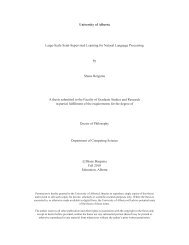The high altitude wildlife areas of western Arunachal Pradesh
The high altitude wildlife areas of western Arunachal Pradesh
The high altitude wildlife areas of western Arunachal Pradesh
Create successful ePaper yourself
Turn your PDF publications into a flip-book with our unique Google optimized e-Paper software.
Chinese goral<br />
Phurgang (Fig. 1) in West Kameng District. <strong>The</strong> goral were seen along a cliff at an<br />
<strong>altitude</strong> <strong>of</strong> 4100 m. We saw them from below at a distance <strong>of</strong> 300 m, and since they were<br />
silhouetted against the sky, we were unable to ascertain whether they were Himalayan or<br />
red goral. However, the hunters accompanying us as guides were positive that they were<br />
red goral, having killed one in the same site a few months back. We also saw fresh signs<br />
<strong>of</strong> takin Budorcas taxicolor and musk deer Moschus sp. in this area.<br />
Two <strong>of</strong> us (CM and AD) saw the Chinese goral, about 3 km from Thingbu village<br />
(Fig. 1), in the Mago Chu Valley <strong>of</strong> Tawang district, while on the trail between Mago<br />
village and Thingbu. We first saw an adult male feeding in an open, steep grassy patch<br />
within fir Abies densa forest at an <strong>altitude</strong> <strong>of</strong> 3000 m. <strong>The</strong> animal had a very dark<br />
chocolate colour, except the lower limbs which were rufous. <strong>The</strong>re was a small but<br />
distinct white throat patch. <strong>The</strong> dorsal side <strong>of</strong> the neck and shoulder had a black patch,<br />
which tapered to become the dorsal stripe, extending till the base <strong>of</strong> the tail. <strong>The</strong> tail was<br />
longer and relatively bushy compared to Himalayan goral. After about 20 minutes, this<br />
animal was joined by a female and young, both <strong>of</strong> which had a relatively lighter coat<br />
colour. We watched this herd for another 15 minutes with binoculars, from a distance <strong>of</strong><br />
c. 600 m, when they slowly disappeared out <strong>of</strong> sight behind some fir trees.<br />
Conservation status<br />
<strong>The</strong> red goral and the Chinese goral are both categorized as ‘Vulnerable’ in the IUCN’s<br />
Red List <strong>of</strong> Threatened Species 29 . Yet, the Indian Wildlife (Protection) Act 1972 does not<br />
list the red goral under any <strong>of</strong> its schedules 30 . <strong>The</strong> Act, in its Schedule III, lists the<br />
Himalayan goral (N. goral), and another species called N. hodgsoni. <strong>The</strong> Himalayan goral<br />
has two subspecies, and the latter presumably is meant to denote the eastern subspecies<br />
Fig. 1. Map <strong>of</strong> <strong>Arunachal</strong> <strong>Pradesh</strong>, showing the location <strong>of</strong> goral Nemorhaedus sp. sightings. We sighted the<br />
red goral N. baileyi near Phurgang, while the Chinese or long-tailed goral N. caudatus was seen near<br />
Thingbu.<br />
31

















